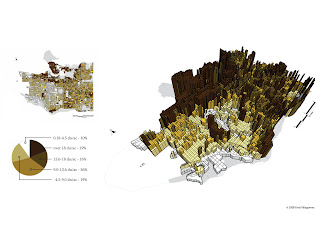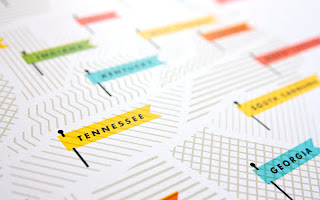Presentation Script Below
- INTRO START: Bicycles have always assisted the community to reach point B. As a clean and environmentally sound method of transportation and exercise, bikes provide us with a cost effective alternative to the gas guzzling world of vehicular travel. (slide 1)
- It's a refreshing and liberating experience, cruising along the city streets, open to the rushing air. Your view is unobstructed by windows and metal. But that poses a great threat to us cyclists. (slide 2)
- We are vulnerable to those still using cars vehicles, and without a safe barrier between us, there will always be conflict between drivers and riders. (slide 3)
- Warning signs, lights and reflectors, and hand signals can only do so much out there on the tarmac. The cycling community suffers from an unending and desperate need for bike lanes.
- (slide 4) And while there are lanes installed though many cities, the department of transportation doesn't have sufficient and reliable information to place them efficiently.
- (slide 5)They need data from the inside. Bike riders need to unite to form a system, a collective concerned for bike safety, and that have an insider perspective on just where these unsafe roads and intersections are.
- So as a graphic designer, the questions is: "Through design, can I create a tool, using information generated by the bike community, that can be used by the Department of Transportation to more effectively place and regulate bike lanes throughout a city."
- The bike community needs HUB. (transition to title slide) (then transition to schematic of system screen)An online GPS system utilizing smart phones and RF bike mounted stickers to not only track where cyclists are riding, but to collect their safety concerns and accidents to determine where routes should and will be installed by the department of transportation.
- (Transition to Personal Image) This is Paul. Paul rides to and from his part time job, and attends business classes at Kansas University. Cycling is all about conquering the gas pump for him, and he enjoys that rush he receives after riding to the top of KU's tallest hills. He's a commuter at heart, and needs to get from place to place rather quickly. This is where Hub comes into play.(Transition to Hub screen.)
- Before heading to work, Paul as a new user will first need to sign in. The app can later save his information, and keep him logged in, so as to save him time in preparation before his rides. (Typing and submitting)
- Once logged in, Paul has the decision to either track a new route to be saved for him, or he can continue to the map in the application, showing previously ridden routes. His current desired route to work hasn't been tracked yet, so he touches the first tracking option.
- When riding or tracking a route, the user's interaction is limited for the cyclist's own safety. Paul simply taps anywhere on the screen to start tracking his new route, and later when Paul finishes his route, he taps once more anywhere on the screen to stop the tracking.
- After his ride, the app asks Paul if he encountered any safety issues. He always has issues around the same spot, and touches yes.
- The app continues to his visualize his route overlaid on a google map of his area. The map is depleted of any color, and with this stark black, white, and orange color scheme, (show outdoor image) users like Paul can use HUB both inside and outside with little trouble. (Fade back to map screen)
- It prompts Paul to touch where on the route he encountered his hazard. He remembers it about hallway between 49th and 50th street. (touches)
- Having taken a photo of his hazard earlier, a series of potholes in the road, he selects the camera, and brings up the photo he wishes to upload. After selecting it, HUB brings up the keyboard to type a comment with it. Paul posts the comment, and it takes him back to the map page. The safety rating icon in the top left flashes to show that his comment has dropped his route's safety rating, and the new image is masked within the safety point he plotted on the route earlier.
- While HUB relies on the bike community for it's data, The Department of Transportation still has a large part to play in the system. While at work, one of the members of the transportation department signs on, to view new user safety postings.
- The system lets them view this information by searching for a particular area by zip code, or by a certain safety rating. This user selects the zip code search option, and enters the number for the plaza/ main street area of Kansas City, which he is in charge of maintaining.
- The map page loads, and any safety hazard posted by the bike community is shown along marked roads. The largest ones with the 1's show which roads have the lowest possible safety rating, and it's those road this worker is most interested in. He selects one...
- and it expands with all user comments posted on that road, as well as their photos. After looking through the comments, the Department user decides this road needs lanes installed, and general maintenance. So to the right side, he enters the estimated completion date for the lanes, and submits it for all HUB users to see and anticipate.
- Later, while Paul is out riding, his phone buzzes with a new notification. So he pulls over to a take a look. He enters the app, and a new notice icon flashes at the bottom on his routes icon. He touches it to see what's new…
- The top street bar expands downward, and presents him with the new lanes expected to be put in on his route. Relieved and anxious, he continues his afternoon ride, happy his morning commute will be that much safer in the future.
- The next morning, Paul pulls out his iphone and enters the app. It takes him right to the tracking screen, but rather than tracking a new route, he continues into the app to select the route to work he tracked yesterday…
- In his "routes section" he can view the other routes he added yesterday afternoon, and the days before. He can pan around and select routes simply by touching them. He can also select the route icon on the bottom bar, and view his routes in a list format. This arranges his routes according to those most and least ridden. But preferring the regular map view, he exits the list view and touches the route to work.
- Once the route is selected, it asks if he's like to start the ride, and he hits yes. However this time a new safety notice pops up. HUB has found a safer route that can get him to his location more safely, and in more quickly to boot. Paul can't argue there, and decides to give the route a try.
- It takes him to the tracking screen, and he touches to start his ride. Much like the GPS units for vehicles, HUB offers him voice turn by turn directions to help him along.
- But near the end of his trip, he get's a bit turned around at an intersection, and stops to get his bearings. HUB detects that he's stopped, and asks if he'd like to see the route map to reorient himself. He hits yes…
- On the map screen, his position is shown on with the route, and he can see which direction he is facing. When he's ready, Paul continues his ride. HUB notices he's now in motion again, and returns to the tracking screen, providing him with those turn by turn vocals until he reaches his destination.
- He stops his tracker, and hasn't encountered any safety issues.
- It asks if he would like to save the new route. He loved the new route, and adds it, knowing that his other route will always be saved if he want's to ride his old way to work.
- HUB users can always highlight a route and expand it's top bar to view in depth information on his tracked rides, including distance, the safety rating, how many times they've ridden the route, and the average ride time it takes to get from start to finish.
- But while maps are useful, some users like Paul enjoy seeing their information at their level, as a civilian on the streets. So he selects the augmented reality icon at the top left.
- This opens the street view, allowing him to view the surrounding area through his phone's camera. He can see the safety hazards that other users have posted in the physical space around him, and can enter one of those postings to see the user's comments and photos of the issue. Paul can even toggle HUB to view bike lanes installed around him, or lanes that are expected in the near future. Always on the lookout for a new safe trip, Paul plots a route to the nearest bike lane for later, and heads into work.
- HUB builds a relationship between the Department of transportation and the bicyclist community. With so many bicyclists out there, lanes must be strategically placed, and by utilizing cyclists throughout the city, HUB will push the road safety system into a new world of mobile GPS technology. Bike riders will shape a safety network for themselves, and HUB would ensure their voices for new lanes and repairs would be heard and respected.





















































